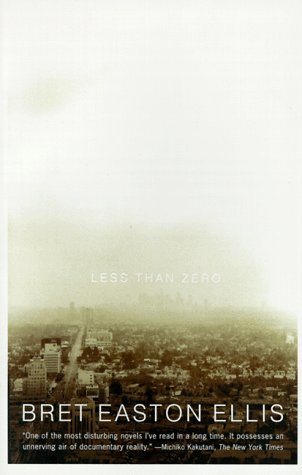
Bret Easton Ellis’ first novel, Less Than Zero, was published while he was just 21 years old, an undergraduate student at Bennington College. It was allegedly assembled from journal entries, dating from his early adolescence, which accounts for its plotless narrative. The book is really a patchwork of experiences – mostly parties, drunken lunches, and drug use – describing what it’s like to grow up wealthy in Los Angeles in the early 1980s. Our narrator-protagonist Clay has just returned to California from his first semester at an unnamed New Hampshire university to pass his winter break among friends and family – an experience he would share with millions of other young men and women each year. But Clay’s family and friends are trapped in a Los Angeles bubble of vicious nihilism, where extreme wealth and ease have reduced life to a quest for pleasure and consumption, stripping it of any greater meaning or purpose.
The cast of characters – Clay, Trent, Blair, Rip, Muriel – comes not from the Bible but from the invention of a makeshift culture. The settings seem equally ephemeral: famous Los Angeles restaurants, mansions with too many rooms and absent parents, and the office of surely the least professional psychiatrist in all of fiction. Wherever Clay goes, he is accompanied by a familiar backdrop: MTV playing on a television screen; pop hits playing on the radio; men and women – truthfully, boys and girls – taking cocaine and valium and quaaludes. Parents are seldom seen – too busy vacationing across the world – but when they are present, they are no more rooted than their children, and much more likely to have had plastic surgery. A representative passage, chosen at random:
I get up late the next morning to the blare of Duran Duran coming from my mother’s room. The door’s open and my sisters are lying on the large bed, wearing bathing suits, leafing through old issues of GQ, watching some porno film on the Betamax with the sound turned off. I sit down on the bed, also in my bathing suit, and they tell me that Mom went out to lunch and that the maid went shopping and I watch about ten minutes of the movie, wondering whose it is – my mom’s? sisters’? Christmas present from a friend? the person with the Ferrari? mine? One of my sisters says that she hates it when they show the guy coming and I walk downstairs, out to the pool, to do my laps.
Clay’s sisters are 13 and 14 years old. In another memorable moment, Clay will accuse them – in front of their mother – of having stolen his cocaine. If this is what the quotidian looks like, then, naturally the bar for fun and excitement gets raised to disturbing heights. The latter half of the novel might be summarized as a series of escalating shocks. Clay and his friends come across a dead body in the back alley behind a nightclub, and rather than call the police or emergency services, they gawk at the corpse, eventually putting a cigarette between its lips. In another scene, they gather in the theatre room of some mansion to watch what appears to be a snuff film: an underage girl, an underage boy, and a menacing, elder black man:
The black man ties the boy up on the floor, and I wonder why there’s a chainsaw in the corner of the room, in the background, and then has sex with him and then he has sex with the girl and then walks off the screen. When he comes back he’s carrying a box. It looks like a toolbox and I’m confused for a minute and Blair walks out of the room. And he takes out an ice pick and what looks like a wire hanger and a package of nails and then a thin, large knife and he comes towards the girl and Daniel smiles and nudges me in the ribs. I leave quickly as the black man tries to push a nail into the girl’s neck.
Something akin to this scene will be acted out in real life shortly after, when Clay arrives at yet another party to discover a girl, “really young and pretty,” tied naked to a bed, kept high by injections from a man named Spin, and a group of young men eager to take their turn raping her. Clay declines to participate, prompting his friend Rip to deliver a response that doubles as a manifesto for this entire lost generation: “What’s right? If you want something, you have the right to take it. If you want to do something, you have the right to do it.”
How much of what is recounted in this novel is lived experience, and how much is sensationalized? I’m afraid even to speculate. But the nihilism it describes, the vapid, drug-and-alcohol fuelled half-life its characters live, has entered the American mainstream, embodied by the noxious celebrity culture California exports across the world. The success of this novel is in its ability to conjure this nihilism, and to force its readers to experience it. But that success is also its great failing, for in its quest to capture California’s culture of nothing, it jettisons fundamental aspects of the novel form: plot and character. As effective as Clay is as a protagonist, he is unknowable as a person, and his mild dissent from the hedonism surrounding him does not rescue him from vacuity, or make him any less unknowable to Ellis’ readers.